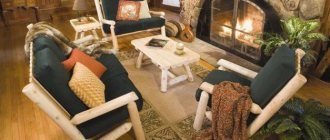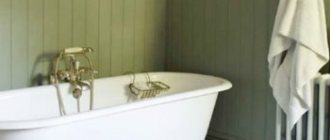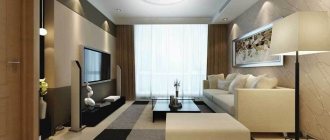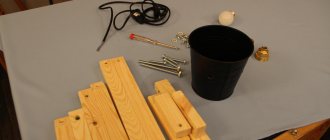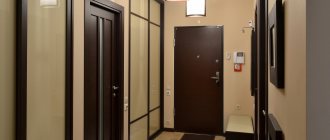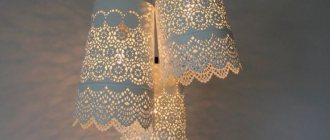Lighting in the interior plays a huge role - it not only fills the darkest corners with light, but also creates the desired atmosphere, emphasizes the style and places the right accents. Westwing talks about the latest lighting trends and shares tips on how to transform your interior with the right light sources.
Multi-level lighting
A multi-level system involves a set of lamps located at different heights, which includes ceiling lamps, sconces, floor lamps and much more. A combination of different lamps allows you to customize the lighting level based on your needs. Tip: for the ceiling, choose lamps with diffused light to create uniform background lighting in the interior, and complement them with floor and table lamps, decorative lighting and sconces.
Lighting allows you to control people's emotions
Light and color are closely interrelated; by changing color you can control the perception of space. Color affects the psychological and physiological state of a person, that is, the body adjusts to a certain atmosphere. For example, green color calms, and red, on the contrary, awakens inner strength and increases activity.
Everyone knows that in cool office lighting, employees do their work much more efficiently. That is, there is an impact on the internal biorhythms of the human body, its activity changes. Do not forget that not only color, light and light “temperature” have an impact, but also the light scenarios implemented in the interior. With the help of light, we can consciously create a particular mood in a room.
For example, to create an environment comfortable for communications, bright, uniform lighting is created. If you need to work in the evening and need to concentrate, then dim the general light and turn on the desk lamp. To create a festive atmosphere in the house, we place light accents and use garlands.
Decorative light can actively control our emotional state. When choosing lamps, the style of the interior plays a big role. The “temperature” of the light is also important. It is better to work in daylight, and to rest in warm light. For example, crystal plays beautifully in “cold temperatures” of more than 4000 K. Warm temperatures include “temperatures” of 2700 K. And this must be taken into account.
Light in a dark interior
Rooms with dark furniture and walls have a special energy: they are filled with comfort and sensuality, looking solid and luxurious. But dark interiors have two disadvantages: firstly, they appear smaller than they actually are, and secondly, they absorb light. To avoid this effect, we recommend providing brighter lighting than for other rooms.
Large shiny chandeliers and shades made of glass or metal will add a glamorous accent, while local light sources will add coziness.
Popular new products in interior lighting
In first place are copper lampshades (with a shiny or matte surface) for both modern and classic lamps. Next, a combination of colors in the fittings, such as gold and chrome, copper and chrome, galvanized gold and matte satin. Now you can forget about the problem of combining interior elements with a lighting fixture (say, the handles on the furniture are golden, and the lamp you like is chrome).
Then, contrasting wires. Sometimes they are not plastic, but fabric; they can be called vintage. Another “fashionable” theme is the floor lamp. It is smaller than a floor lamp, but larger than a table lamp. Lamps with silicone lampshades are also gaining popularity.
It is worth noting the loft-style lamps, designed for free spaces, where there are a lot of raw textures, bricks, and concrete. Most often these are metal devices with an open light source. LEDs are not suitable for them, and therefore incandescent lamps are used.
In addition, lamps that create a certain pattern on the wall or ceiling are in fashion, which looks very impressive. Another modern trend is small chandeliers instead of sconces in the bedroom on the sides of the bed.
More light!
Crystal or glass chandeliers are not only a symbol of luxury, but also a great opportunity to increase light. Reflecting and refracting in the pendants, it is scattered throughout the room, creating the effect of bright lighting. Westwing secret: place a chandelier or sconce in front of a mirror, and the room will become twice as bright!
Modern preferences in decorative lighting
Increasingly, buyers have become interested in zone lighting. One chandelier in the room is already yesterday. Now people buy not only sconces, but also floor lamps, and make additional interior lighting of a technical nature. Such a concept as architectural light has appeared - these are plaster lamps, which involve installing lamps directly inside the wall. Such devices can be painted, wallpapered, and decorated, which allows you to create light zones integrated into the interior in accordance with its style.
It is worth mentioning the lamps, which we call art objects. They combine functionality and decor. These are, for example, mirrors, which are also lighting devices.
Due to the improvement of LEDs and their availability, buyers have the opportunity to purchase a set of necessary elements and assemble a lighting system themselves. There are many videos on the Internet demonstrating how to make a lamp from scrap materials - from a felt boot, a book, an old umbrella, etc. Now this is very popular.
Light intensity
Do you want bright light for reading, dim light for a romantic dinner, and background light for relaxing after work? All this can be achieved with one lamp, if you use a dimmer - a lighting power regulator. It allows you to create the desired atmosphere, adjust the lighting intensity to suit your needs and save energy.
Lighting in a small room with low ceilings
A small room imposes restrictions on the choice of furniture and color scheme, but properly selected lighting can brighten up the shortcomings of small rooms. The first rule is to avoid bulky lamps and massive chandeliers. They are also unacceptable in a room with low ceilings, as they make them visually lower. The ideal solution is a flat ceiling lamp with shades pointing upward: the reflected light will optically lift the ceiling and push the walls apart.
LEDs in the house: strips, lamps, panels
LEDs in home interiors are a fashion that is spreading literally by leaps and bounds. Initially, they were used in emergency and local lighting, but today they are widely used for interior decoration, and, increasingly, for basic lighting of home premises.
LEDs captivate with their efficiency, reliability and environmental friendliness, endless scope for design ideas and ease of installation: a home craftsman is quite capable of realizing his “lighting” fantasies on his own, without the help of specialists. Many FORUMHOUSE users have long appreciated these possibilities and successfully use LED lamps, luminaires and strips not only for illumination of plants and outdoor lighting of the house and area, but also as decor and main lighting in their homes. It's time to summarize their experience.
Advantages of LED lighting:
• Reliability and safety of use.
• Durability, high service life.
• Resistance to vibration, humidity and temperature fluctuations.
• Energy efficiency.
• Wide possibilities for design and decoration.
• Ability to adjust lighting intensity and color changes.
• No harmful ultraviolet radiation.
The main disadvantage of LEDs is still their high cost. And although they are becoming more affordable every year, using LEDs as the main light in large rooms is an expensive pleasure that will not pay for itself in energy savings. However, is this really necessary? Like any fashion trend, even the most useful one that makes life more comfortable, the use of LEDs for home lighting should be treated with caution. Inspired by the properties of “magic crystals” and encouraged by sellers, many householders strive to install LED lamps and strips everywhere, even in a bathhouse with a sauna. From the point of view of comfort and economy, this is not justified in all cases.
The LED strip, popular today , is intended primarily for decorative lighting and only secondarily for lighting. Making basic lighting using LED strips is expensive and uneconomical due to high power consumption. Tapes on the ceiling and walls are placed in niches, profiles, behind cornices, etc., and therefore have a very low efficiency of light use: basically you will only see reflected light, several times less than the tape produces. Everything else remains in the niche.
Many people are inspired by the idea of a “glowing” suspended ceiling. But to implement it using LED strips, you will have to spend a lot of money. Firstly, expensive high-quality components will be required. Saving on them may later turn into a loss if you have to dismantle the ceiling due to the tapes failing. In addition, installing such a ceiling from tapes in a high-quality manner is not an easy task. To obtain a uniformly luminous surface, the LEDs must be positioned in such a way that in any axis the step between them is the same and less than the distance to the scattering plane, explains forum member Egor Kirov. If these conditions are not met, the ceiling will glow unevenly, in stripes. Therefore, the tapes have to be brought close to each other, and you will need a lot of them: up to eight or nine lines per meter. This type of lighting obviously cannot be called economical and inexpensive.
EgorKirov:
– The characteristics of the tape do not exceed 50-60 Lm/W, whereas even for Chinese consumer goods lamps it starts at 80 Lm/W, and for good lamps – 100-120 Lm. Manufacturers often overestimate the declared parameters of the tape in terms of luminous flux. And the economic sense of the tape with an output of 750 lm/meter is, to put it mildly, incomprehensible.
Even in small spaces, for example, in a corridor, when using strips as the main light source, you will have to use them brighter and more powerful: 9.6, or better yet, 14.4 watts per meter.
Another thing is the lighting of individual interior elements. This is where LED strips will come in very handy. By placing the tape around the perimeter of the ceiling of a small room, you can visually expand its size. In a large room, in combination with the main light from the lamps, strips illuminating different levels of the suspended ceiling will work effectively. In the kitchen, LED strips are used to illuminate the work surface or bar counter and interior spaces in cabinets.
The power of the strip's power supply must necessarily exceed the total power of all its LEDs, preferably with a margin. The power is calculated using the formula: tape footage * power of 1 meter of tape * 1.3 = minimum required power of the power supply. So, for a meter of tape with a power of 14 W/m, a power supply of at least 1 * 14 * 1.3 = 18.2 W is required.
A lot of useful practical information about the features of installing LED strips and advice from experienced users can be found in this section of FOREMHOUSE.
Another option for LED lighting that is rapidly gaining popularity is LED panels . They are available in various colors and sizes, have low energy consumption with high light output, and therefore can be successfully used for basic lighting, especially in small and medium-sized rooms. LED panels can be very thin (8-25 mm), and therefore are good for use in apartments with low ceilings.
The panels can be mounted on suspended systems, built into a suspended ceiling or wall niches. The versatility of installation allows them to be successfully used to visually divide rooms into separate functional zones. Panels of different shapes and different color shades are suitable for emphasizing individual interior details. In the hallway, corridor, or bathroom, several panels with a power of 12-15 watts placed on the ceiling at a distance of 1.2-1.5 meters from each other can be a good option, advises forum user Dale85. For basic lighting, you should not choose panels with a cold glow (White marking).
When choosing LED lamps and luminaires, it is important to understand that if in traditional incandescent lamps there was a direct connection “higher power - more light”, then with LEDs the situation is different. Choosing an LED light based solely on its power consumption would be a mistake.
The efficiency criterion of an LED lamp is luminous efficiency, which shows how much light a lamp or luminaire absorbs for each watt of its power. It is measured by the ratio of luminous flux to power - lumens/watt (these two parameters must be indicated by the manufacturer on the lamp packaging). The higher the luminous efficiency, the brighter the lamp.
Modern LED lamps have, on average, a light output in the range of 90-130 Lm/W. For comparison: a traditional 100-watt incandescent lamp “produces” a luminous flux of a maximum of 1200-1300 lumens, that is, its light output is only 12-13 Lm/W.
Manufacturers often place information on the packaging of LED lamps
that the power of a given lamp is equivalent to the power of an incandescent lamp of the same brightness. It would seem that this helps the buyer make a choice, focusing on the usual parameter - power. However, in reality such information can be misleading. For example, if on the packaging of a 4-watt LED lamp with a stated luminous flux of 280 lm it is written that it is equivalent in light parameters to a 50-watt incandescent lamp, this is obvious deceit. The luminous flux intensity of a 50 W incandescent lamp is twice as high - 500-600 Lm.
When choosing LED lamps, you must also keep in mind that the brightness of the lamp will in fact always be slightly lower than the brightness of the LEDs that are used in it, declared by the manufacturer, since the efficiency of power supplies usually does not exceed 80-85%, and about another 10 percent of the luminous flux can “get lost” due to the reflector and glass.
Egor Kirov:
– If typical modern LEDs have a light output of 110-130 Lm/W, then in a spotlight (lamp) made from these same LEDs, the ratio will be, due to losses (efficiency) of the driver, at the level of 80-100 Lm/W.
When choosing LED lamps and accessories for them, do not forget to check with the seller about the terms of the warranty, and ask whether the lighting device can be repaired. And you shouldn’t chase cheapness: an unreasonably low price for LEDs is a sure sign of low quality. Lamps with cheap crystals most likely will not “give” the declared parameters and may fail at any time. It’s easier to save on chandeliers and lamp bodies.
Dale85:
– Many comrades buy, for example, a housing for a recessed lamp for 1500-2000 rubles (although they are not visible when the light is on, and no one looks at the lamps), but they want to buy a light bulb for these lamps for 100 rubles, so that they will last forever. Saving on housings allows you to buy a normal LED lamp.
For examples of using LEDs as lighting, tips and recommendations for choosing and installing LED lamps, look in this and this section of the forum. Here is a discussion of the experience of using LED panels. Members of the forum share their experience of using LEDs in crop production in this thread. This video is a story about how to make a simple but effective LED lamp for growing seedlings on a windowsill with your own hands.
Popular trend: LED lighting
Over the past years, LED lighting for furniture, floors and walls has remained the number one trend in interior lighting.
There are many possibilities for its use: LED lamps built into the baseboard, floor and walls, LED strips, furniture with built-in light sources and much more. Tip: use LED floor lighting in the hallway for easy movement in the dark, or highlight a functional area in the living room, for example, highlight a bar counter or TV.

